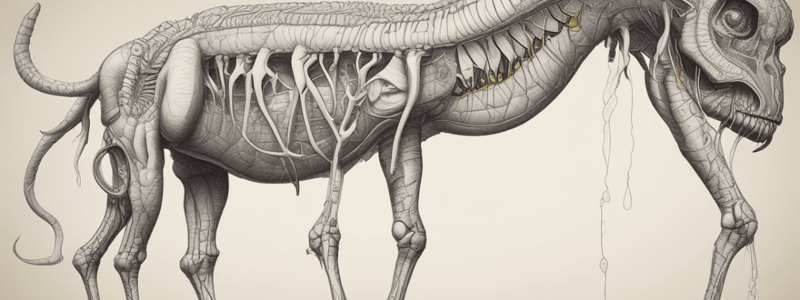Podcast
Questions and Answers
What is the main function of body coverings in animals?
What is the main function of body coverings in animals?
- To attract mates and defend territories
- To protect their internal organs, bones, and muscles (correct)
- To help them move and communicate
- To regulate their body temperature
Which of the following animals uses its tail for steering and movement?
Which of the following animals uses its tail for steering and movement?
- Fish (correct)
- Monkey
- Bird
- Deer
What is a common function of limbs in animals?
What is a common function of limbs in animals?
- To protect them from predators
- To help them walk, run, climb, swim, and more (correct)
- To facilitate breathing
- To regulate body temperature
What is a specific function of a deer's tail?
What is a specific function of a deer's tail?
What is a common feature of limbs in animals?
What is a common feature of limbs in animals?
What is the primary function of sensory organs in an animal's head?
What is the primary function of sensory organs in an animal's head?
What is the main purpose of an animal's body covering?
What is the main purpose of an animal's body covering?
Which of the following is an example of a specialized sensory organ?
Which of the following is an example of a specialized sensory organ?
What is the primary function of a brain in an animal?
What is the primary function of a brain in an animal?
What is a common feature shared by most animals?
What is a common feature shared by most animals?
Flashcards are hidden until you start studying
Study Notes
External Structures
- Most animals have a head, body covering, limbs, and some form of a tail, which are crucial for survival and reproduction.
Head
- The head structure protects the brain, which is responsible for thinking and behaviors.
- The head contains a mouth for feeding and taking in nutrients and food necessary for survival.
- Sensory organs, such as eyes, ears, and nose, are also located on the head and help animals sense their environment.
- Different sensory organs have become specialized in different animals, e.g., hawks have sharp eyesight for spotting prey, and dogs have a keen sense of hearing for warning them of danger.
Body Coverings
- Body coverings are the external materials that cover an animal's body, varying according to their needs.
- Examples of body coverings include fur, scales, skin, feathers, and shells.
- Body coverings protect animals' internal organs, bones, and muscles, and shield them from their environment.
- Some body coverings help animals adapt to their environment, e.g., polar bears have a layer of fat and thick fur for cold climates, and frogs have camouflage body coverings to hide from predators.
- Male animals may have colorful or bright body coverings to attract females for mating and reproduction.
Tail
- Tails help animals move, e.g., fish, dolphins, and birds use their tails for steering and movement.
- Some animals use their tails for communication, e.g., dogs wag their tails when greeting, and deer flash the white part of their tail to warn other deer of predators.
- Tails can also be used to keep an animal warm or keep insects away from it.
Limbs
- Limbs are external structures that project from an animal's body and perform specific functions.
- Examples of limbs include arms, wings, legs, webbed feet, tentacles, fins, and flippers.
- Limbs help animals walk, run, climb, swim, and more, which enable them to find and catch food or escape predators to grow and survive.
Studying That Suits You
Use AI to generate personalized quizzes and flashcards to suit your learning preferences.




